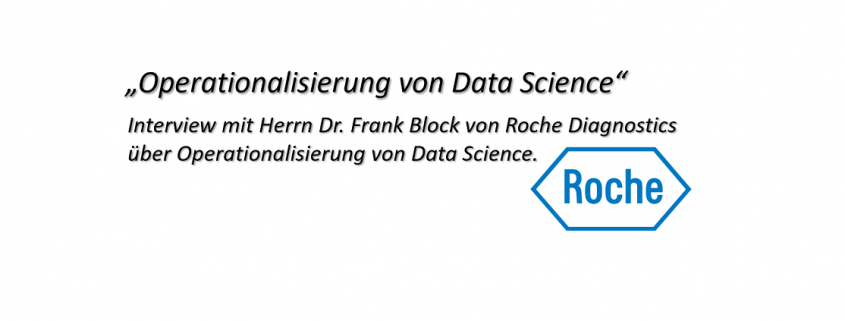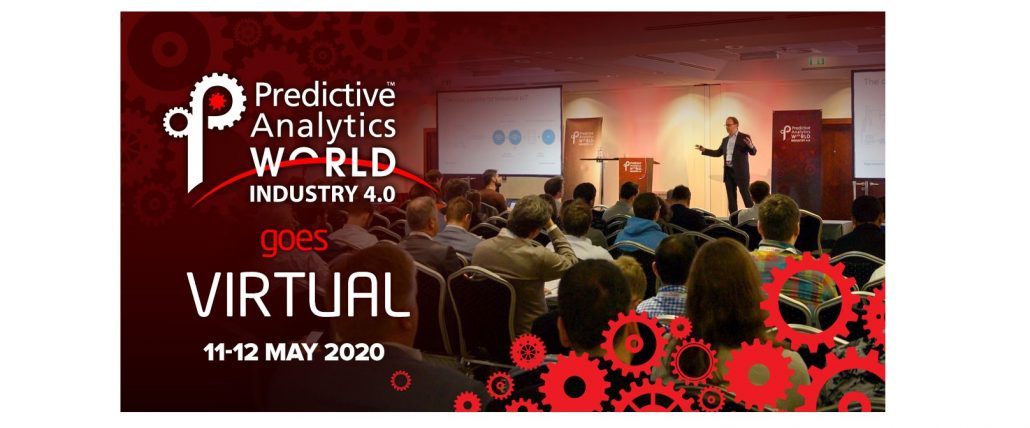Interview: Operationalisierung von Data Science
Interview mit Herrn Dr. Frank Block von Roche Diagnostics über Operationalisierung von Data Science
 Herr Dr. Frank Block ist Head of IT Data Science bei Roche Diagnostics mit Sitz in der Schweiz. Zuvor war er Chief Data Scientist bei der Ricardo AG nachdem er für andere Unternehmen die Datenanalytik verantwortet hatte und auch 20 Jahre mit mehreren eigenen Data Science Consulting Startups am Markt war. Heute tragen ca. 50 Mitarbeiter bei Roche Diagnostics zu Data Science Projekten bei, die in sein Aktivitätsportfolio fallen:
Herr Dr. Frank Block ist Head of IT Data Science bei Roche Diagnostics mit Sitz in der Schweiz. Zuvor war er Chief Data Scientist bei der Ricardo AG nachdem er für andere Unternehmen die Datenanalytik verantwortet hatte und auch 20 Jahre mit mehreren eigenen Data Science Consulting Startups am Markt war. Heute tragen ca. 50 Mitarbeiter bei Roche Diagnostics zu Data Science Projekten bei, die in sein Aktivitätsportfolio fallen:
Data Science Blog: Herr Dr. Block, Sie sind Leiter der IT Data Science bei Roche Diagnostics? Warum das „IT“ im Namen dieser Abteilung?
Roche ist ein großes Unternehmen mit einer großen Anzahl von Data Scientists in ganz verschiedenen Bereichen mit jeweils sehr verschiedenen Zielsetzungen und Themen, die sie bearbeiten. Ich selber befinde mich mit meinem Team im Bereich „Diagnostics“, d.h. der Teil von Roche, in dem Produkte auf den Markt gebracht werden, die die korrekte Diagnose von Krankheiten und Krankheitsrisiken ermöglichen. Innerhalb von Roche Diagnostics gibt es wiederum verschiedene Bereiche, die Data Science für ihre Zwecke nutzen. Mit meinem Team sind wir in der globalen IT-Organisation angesiedelt und kümmern uns dort insbesondere um Anwendungen von Data Science für die Optimierung der internen Wertschöpfungskette.
Data Science Blog: Sie sind längst über die ersten Data Science Experimente hinaus. Die Operationalisierung von Analysen bzw. analytischen Applikationen ist für Sie besonders wichtig. Welche Rolle spielt das Datenmanagement dabei? Und wo liegen die Knackpunkte?
Ja, richtig. Die Zeiten, in denen sich Data Science erlauben konnte „auf Vorrat“ an interessanten Themen zu arbeiten, weil sie eben super interessant sind, aber ohne jemals konkrete Wertschöpfung zu liefern, sind definitiv und ganz allgemein vorbei. Wir sind seit einigen Jahren dabei, den Übergang von Data Science Experimenten (wir nennen es auch gerne „proof-of-value“) in die Produktion voranzutreiben und zu optimieren. Ein ganz essentielles Element dabei stellen die Daten dar; diese werden oft auch als der „Treibstoff“ für Data Science basierte Prozesse bezeichnet. Der große Unterschied kommt jedoch daher, dass oft statt „Benzin“ nur „Rohöl“ zur Verfügung steht, das zunächst einmal aufwändig behandelt und vorprozessiert werden muss, bevor es derart veredelt ist, dass es für Data Science Anwendungen geeignet ist. In diesem Veredelungsprozess wird heute noch sehr viel Zeit aufgewendet. Je besser die Datenplattformen des Unternehmens, umso größer die Produktivität von Data Science (und vielen anderen Abnehmern dieser Daten im Unternehmen). Ein anderes zentrales Thema stellt der Übergang von Data Science Experiment zu Operationalisierung dar. Hier muss dafür gesorgt werden, dass eine reibungslose Übergabe von Data Science an das IT-Entwicklungsteam erfolgt. Die Teamzusammensetzung verändert sich an dieser Stelle und bei uns tritt der Data Scientist von einer anfänglich führenden Rolle in eine Beraterrolle ein, wenn das System in die produktive Entwicklung geht. Auch die Unterstützung der Operationalisierung durch eine durchgehende Data Science Plattform kann an dieser Stelle helfen.
Data Science Blog: Es heißt häufig, dass Data Scientists kaum zu finden sind. Ist Recruiting für Sie tatsächlich noch ein Thema?
Generell schon, obwohl mir scheint, dass dies nicht unser größtes Problem ist. Glücklicherweise übt Roche eine große Anziehung auf Talente aus, weil im Zentrum unseres Denkens und Handelns der Patient steht und wir somit durch unsere Arbeit einen sehr erstrebenswerten Zweck verfolgen. Ein zweiter Aspekt beim Aufbau eines Data Science Teams ist übrigens das Halten der Talente im Team oder Unternehmen. Data Scientists suchen vor allem spannenden und abwechselnden Herausforderungen. Und hier sind wir gut bedient, da die Palette an Data Science Anwendungen derart breit ist, dass es den Kollegen im Team niemals langweilig wird.
Data Science Blog: Sie haben bereits einige Analysen erfolgreich produktiv gebracht. Welche Herausforderungen mussten dabei überwunden werden? Und welche haben Sie heute noch vor sich?
Wir konnten bereits eine wachsende Zahl an Data Science Experimenten in die Produktion überführen und sind sehr stolz darauf, da dies der beste Weg ist, nachhaltig Geschäftsmehrwert zu generieren. Die gleichzeitige Einbettung von Data Science in IT und Business ist uns bislang gut gelungen, wir werden aber noch weiter daran arbeiten, denn je näher wir mit unseren Kollegen in den Geschäftsabteilungen arbeiten, umso besser wird sichergestellt, das Data Science sich auf die wirklich relevanten Themen fokussiert. Wir sehen auch guten Fortschritt aus der Datenperspektive, wo zunehmend Daten über „Silos“ hinweg integriert werden und so einfacher nutzbar sind.
Data Science Blog: Data Driven Thinking wird heute sowohl von Mitarbeitern in den Fachbereichen als auch vom Management verlangt. Sind wir schon so weit? Wie könnten wir diese Denkweise im Unternehmen fördern?
Ich glaube wir stecken mitten im Wandel, Data-Driven Decisions sind im Kommen, aber das braucht auch seine Zeit. Indem wir zeigen, welches Potenzial ganz konkrete Daten und Advanced Analytics basierte Entscheidungsprozesse innehaben, helfen wir, diesen Wandel voranzutreiben. Spezifische Weiterbildungsangebote stellen eine andere Komponente dar, die diesen Transformationszrozess unterstützt. Ich bin überzeugt, dass wenn wir in 10-20 Jahren zurückblicken, wir uns fragen, wie wir überhaupt ohne Data-Driven Thinking leben konnten…








 Ronny Fehling is Partner and Associate Director for Artificial Intelligence as the Boston Consulting Group GAMMA. With more than 20 years of continually progressive experience in leading business and technology innovation, spearheading digital transformation, and aligning the corporate strategy with Artificial Intelligence he industry-leading organizations to grow their top-line and kick-start their digital transformation.
Ronny Fehling is Partner and Associate Director for Artificial Intelligence as the Boston Consulting Group GAMMA. With more than 20 years of continually progressive experience in leading business and technology innovation, spearheading digital transformation, and aligning the corporate strategy with Artificial Intelligence he industry-leading organizations to grow their top-line and kick-start their digital transformation.



